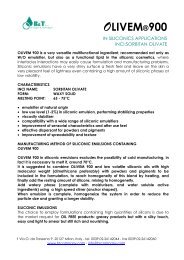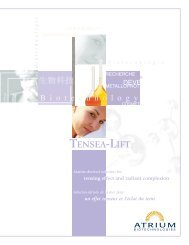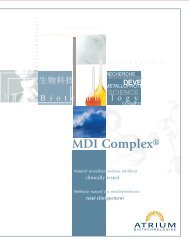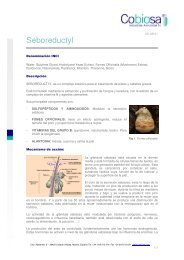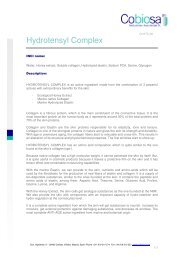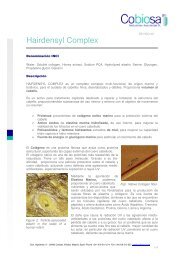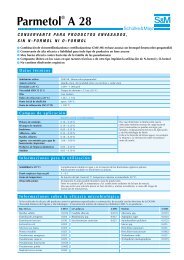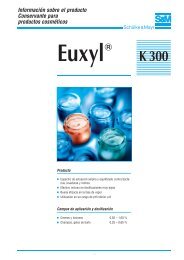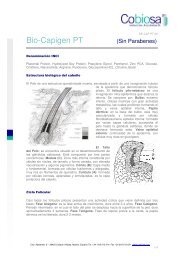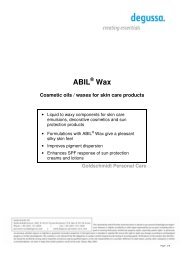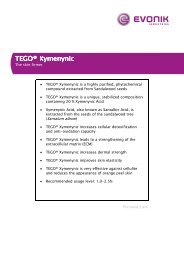ISOLAN PDI e - Quetzal Quimica
ISOLAN PDI e - Quetzal Quimica
ISOLAN PDI e - Quetzal Quimica
You also want an ePaper? Increase the reach of your titles
YUMPU automatically turns print PDFs into web optimized ePapers that Google loves.
<strong>ISOLAN</strong> ® <strong>PDI</strong><br />
Emulsifier for the formulation of cosmetic<br />
W/O creams and lotions.<br />
• Emulsifier for elegant W/O emulsions with a<br />
brilliant white appearance and pleasant<br />
application properties<br />
• Low usage concentration (approx. 3.0 %)<br />
• Stable emulsions without co-emulsifiers and<br />
with low amounts of consistency-enhancing<br />
waxes<br />
• Formulations with all kinds of cosmetic oils<br />
• High compatibility with active ingredients<br />
• Emulsions with good heat and freeze stability<br />
• PEG-free W/O emulsifier based on natural raw<br />
materials<br />
• Liquid at room temperature<br />
Goldschmidt Personal Care<br />
Page 1 of 6
INCI name (CTFA name)<br />
Diisostearoyl Polyglyceryl-3 Dimer Dilinoleate<br />
Chemical and physical properties<br />
(not part of specifications)<br />
Form<br />
Colour<br />
liquid<br />
yellow<br />
HLB-value approx. 5<br />
Application<br />
<strong>ISOLAN</strong> ® <strong>PDI</strong> is a PEG-free W/O emulsifier<br />
based on natural raw materials. Due to ist<br />
polymeric and polyfunctional structure <strong>ISOLAN</strong> ®<br />
<strong>PDI</strong> has a high stabilizing effect on emulsions.<br />
• <strong>ISOLAN</strong> ® <strong>PDI</strong> is suitable for the formulation<br />
of cosmetic W/O creams and lotions.<br />
• The amount used, based on the whole<br />
emulsion, is approx. 3.0 %.<br />
• Consistency-enhancing or emulsionstabilising<br />
waxes are only required in<br />
amounts up to 2 %. Recommended are<br />
hydrogenated castor oil in combination with<br />
high-melting hydrocarbon waxes or<br />
beeswax.<br />
• The optimum range for the oil phase content<br />
is 20 - 32 % for creams and<br />
24 - 35 % for lotions.<br />
• Substances which can be processed include<br />
not only mineral oils, which in emulsions<br />
provide relatively few problems, but also fatty<br />
acid esters of short- and long-chained<br />
alcohols and vegetable triglycerides which<br />
are often difficult to emulsify.<br />
• Emulsions in which the oil phase mainly<br />
consists of lipids with good spreading<br />
properties have good rub-in characteristics<br />
and are rapidly absorbed by the skin. On the<br />
other hand, creams which contain only high<br />
viscous oils, e. g. vegetable triglycerides, for<br />
a "more rich" skin feel, maintain good<br />
application profiles.<br />
• The creams and lotions are distinguished by<br />
high stability towards heat and freezing<br />
stress; stable emulsions between -25 °C and<br />
+50 °C are attainable.<br />
Influence on the viscosity of the emulsion<br />
The viscosity of W/O emulsions based on<br />
<strong>ISOLAN</strong> ® <strong>PDI</strong> can be adjusted by three<br />
variables.<br />
1. Viscosity of the oil phase<br />
The viscosity of the external phase correlates<br />
directly with the viscosity of the emulsion. This<br />
means that it increases if low viscous oils in a<br />
formulation are replaced by higher viscous oils<br />
or if waxes are added; even at a concentration<br />
of 0.5 - 2.0%.<br />
2. Phase ratio<br />
In emulsions with a high content of dispersed<br />
phase - as in the cosmetic W/O emulsions - the<br />
viscosity increases significantly when the<br />
proportion of the dispersed internal phase is<br />
increased. The reason for this is the interaction<br />
between the dispersed water droplets which<br />
becomes stronger with the increased packing<br />
density. Therefore <strong>ISOLAN</strong> ® <strong>PDI</strong> creams on<br />
average have a lower oil content than lotions.<br />
Depending on the emulsifiable substances,<br />
creams can be prepared with 20 - 32 % and<br />
lotions with 24 - 35 % oil phase.<br />
Page 2 of 6
A given oil phase can be processed to form<br />
stable viscous liquid or cream-like emulsions<br />
when its proportion is in the optimum range for<br />
stability of the emulsion.<br />
3. Degree of dispersion<br />
An additional parameter having an influence on<br />
viscosity is the degree of dispersion. This<br />
should not be used to regulate the viscosity due<br />
to its effect on the stability of the emulsion.<br />
When the viscosity increases, due to<br />
mechanical processing, the diameter of the<br />
droplets is reduced and the specific boundary<br />
area between the phases is increased.<br />
For this reason cream formulations are often<br />
still liquid in the pre-emulsion state because of<br />
their coarse degree of dispersion.<br />
Preparation<br />
A pre-requisite for this is careful adjustment of<br />
the formulation (phase ratio, viscosity of the oil<br />
phase) and optimum emulsification.<br />
The particle size for creams which are stable<br />
over a long period of time is below 1 µm, for<br />
lotions approx. 2 - 4 µm. More coarsely<br />
dispersed emulsions tend to separate.<br />
Thorough, but not too intensive homogenization<br />
is required. Extreme energy input frequently<br />
causes the formation of highly viscous,<br />
metastable secondary structures which break<br />
down on storage. Under such conditions lotions<br />
may transiently reach cream-like consistency,<br />
e. g. by several passages through a colloid mill.<br />
Optimum manufacturing conditions correspond<br />
to the principles of normal production<br />
processes for W/O emulsions.<br />
The water phase is incorporated slowly into the<br />
oil phase which contains the emulsifier while<br />
stirring intensively. The coarsely dispersed preemulsion<br />
is then homogenized. The final<br />
homogenization should be performed below<br />
30 °C.<br />
The temperature programme is variable and<br />
can take the form of:<br />
• hot/hot procedure (H/H)<br />
• hot/cold procedure (H/C)<br />
In addition to the traditional hot/hot procedure<br />
(both phases 80 - 90 °C) the hot/cold procedure<br />
can be used. It is characterised by<br />
incorporation of the cold water phase<br />
(15 - 30 °C) into the hot oil phase which<br />
significantly shortens the time of manufacture.<br />
Homogenization should be carried out below 30<br />
°C in order to ensure that the waxes have<br />
recrystallised.<br />
The decisive criterion for production is the<br />
viscosity. Mechanical processing is discontinued<br />
when the viscosity is equal to that of<br />
the standard emulsion developed and tested in<br />
the laboratory.<br />
Emulsifying machines<br />
Stirring equipment or planetary mixers with high<br />
sheering force are suitable for the manufacture<br />
of creams and lotions in the laboratory and<br />
production scale, provided that they can insure<br />
uniform work-up of the emulsion. Machines<br />
predominately used in the cosmetic industry,<br />
which are equipped with stirrer, stripper and<br />
rotor-stator homogenizer, fulfil all requirements<br />
for optimum emulsification.<br />
Page 3 of 6
However, utilization of their maximum capacity<br />
may result in over-emulsification. High-pressure<br />
emulsifiers may cause problems because of the<br />
danger of over-emulsification and liberation of<br />
water due to cavitation.<br />
Recommended usage concentration<br />
approx. 3.0 %<br />
Packaging<br />
4 x 200 kg drum<br />
900 kg container<br />
Hazardous goods classification<br />
Information concerning<br />
− classification and labelling according to<br />
regulations for transport and for dangerous<br />
substances<br />
− protective measures for storage and<br />
handling<br />
− measures in case of accidents and fires<br />
− toxicity and ecological effects<br />
is given in our material safety data sheets.<br />
We recommend to store <strong>ISOLAN</strong> ® <strong>PDI</strong> at room<br />
temperature to keep the product pumpable.<br />
Page 4 of 6
Guide Line Formulations<br />
W/O Lotion<br />
F 11/97<br />
Phase A<br />
<strong>ISOLAN</strong> ® <strong>PDI</strong> 3.0 %<br />
Hydrogenated Castor Oil 0.3 %<br />
Microcrystalline Wax 1) 0.2 %<br />
TEGOSOFT ® DO 7.0 %<br />
TEGOSOFT ® P 7.5 %<br />
TEGOSOFT ® CT 7.0 %<br />
Phase B<br />
Magnesium Sulfate Heptahydrate 1.0 %<br />
Water 74.0 %<br />
Preservative, Perfume<br />
q.s.<br />
W/O Cream (light)<br />
F 6/99<br />
Phase A<br />
<strong>ISOLAN</strong> ® <strong>PDI</strong> 3.0 %<br />
Hydrogenated Castor Oil 0.5 %<br />
Microcrystalline Wax 1) 0.5 %<br />
TEGOSOFT ® P 5.0 %<br />
TEGOSOFT ® CI 6.0 %<br />
Ethylhexyl Octanoate 6.0 %<br />
Phase B<br />
Glycerin 2.0 %<br />
Magnesium Sulfate Heptahydrate 1.0 %<br />
Water 76.0 %<br />
Preservative, Perfume<br />
q.s.<br />
1) e. g. Paracera M, Paramelt B. V.<br />
W/O Hand Cream<br />
F 51/96<br />
Phase A<br />
<strong>ISOLAN</strong> ® <strong>PDI</strong> 3.0 %<br />
TEGOSOFT ® liquid 9.5 %<br />
TEGOSOFT HP 9.5 %<br />
Beeswax 0.6 %<br />
Hydrogenated Castor Oil 0.4 %<br />
Phase B<br />
Glycerin 3.0 %<br />
Magnesium Sulfate Heptahydrate 1.0 %<br />
Water 73.0 %<br />
Preservative, Perfume<br />
q.s.<br />
W/O Cream with Ethanol<br />
F 7/99<br />
Phase A<br />
<strong>ISOLAN</strong> ® <strong>PDI</strong> 3.0 %<br />
Beeswax 1.2 %<br />
Hydrogenated Castor Oil 0.8 %<br />
Mineral Oil (30 mPas) 10.0 %<br />
Isohexadecane 10.0 %<br />
Phase B<br />
Glycerin 3.0 %<br />
Magnesium Sulfate Heptahydrate 1.0 %<br />
Water 61.0 %<br />
Phase C<br />
Ethanol 10.0 %<br />
Preservative, Perfume<br />
q.s.<br />
Page 5 of 6
W/O Sun Protection Lotion<br />
Ma 83/98<br />
Phase A<br />
<strong>ISOLAN</strong> ® <strong>PDI</strong> 3.0 %<br />
Beeswax 0.2 %<br />
Hydrogenated Castor Oil 0.3 %<br />
Ethylhexyl Methoxycinnamate 4.0 %<br />
Butyl Methoxydibenzoylmethane 2.0 %<br />
TEGOSOFT ® TN 9.0 %<br />
TEGOSOFT ® CT 8.5 %<br />
TEGOSOFT ® MM 1.0 %<br />
Phase B<br />
Glycerin 3.0 %<br />
Magnesium Sulfate Heptahydrate 0.6 %<br />
Water 68.4 %<br />
Preservative, Perfume<br />
q.s.<br />
W/O Sun Protection Cream with Zinc<br />
Oxide<br />
F 91/96<br />
Phase A<br />
<strong>ISOLAN</strong> ® <strong>PDI</strong> 3.0 %<br />
Mineral Oil (30 mPas) 12.0 %<br />
TEGOSOFT ® CT 12.0 %<br />
Hydrogenated Castor Oil 0.8 %<br />
Microcrystalline Wax 1) 1.2 %<br />
Ethylhexyl Methoxycinnamate 5.0 %<br />
Isostearic Acid 1.0 %<br />
Zinc Oxide 5.0 %<br />
Phase B<br />
Glycerin 3.0 %<br />
Magnesium Sulfate Heptahydrate 0.5 %<br />
Water 56.5 %<br />
Preservative, Perfume<br />
q.s.<br />
W/O Sun Protection Cream (high SPF)<br />
Ma 43/98-6<br />
Phase A<br />
<strong>ISOLAN</strong> ® <strong>PDI</strong> 3.00 %<br />
TEGOSOFT ® OS 11.75 %<br />
Mineral Oil (30 mPas) 11.50 %<br />
ABIL ® Wax 9840 0.25 %<br />
Hydrogenated Castor Oil 0.50 %<br />
Microcrystalline Wax 1) 1.00 %<br />
Isostearic Acid 1.00 %<br />
Ethylhexyl Methoxycinnamate 7.00 %<br />
Zinc Oxide 15.00 %<br />
Titanium Dioxide (and) Alumina (and)<br />
Simethicone 2) 4.00 %<br />
Phase B<br />
Water 44.50 %<br />
Magnesium Sulfate Heptahydrate 0.50 %<br />
Preservative, Perfume<br />
q.s.<br />
1) e. g. Paracera W 80, Paramelt B. V.<br />
2) e. g. Eusolex T 2000, Merck<br />
E 01/00<br />
Page 6 of 6



